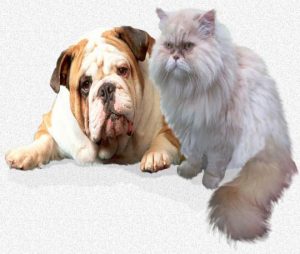Anesthesia In Your Dog And Cat
Ron Hines DVM PhD
 Pain control In your dog & cat
Pain control In your dog & cat
When your cat or dog is scheduled to undergo a surgical procedure most pet owners’ first thought is the risk of anesthesia. That’s perfectly natural – the risks of general anesthesia in some pets is greater than that of the surgery itself.
All veterinarians know this and share your concerns. Today’s veterinarians are fortunate. The older, less predictable, anesthetics have long since been replaced by medications that are much more predictable and safe when properly used. Unlike the intravenous compounds veterinarians used in the past, gas anesthetic like isoflurane and sevoflurane that veterinarians use today quickly dissipate from your dog and cat’s body. Their effects on your pet are quickly reversed by its natural or assisted ventilation (breathing) and leave your pet’s body rapidly. That lets your veterinarian and his or her nurse almost immediately adjust your pet’s depth of anesthesia. Newer injectable anesthetics for more minor procedures in dogs such as dexmedetomidine (Dexdomitor®) have their own specific reversal agent, atipamezole (Antisedan®) and the combination of tiletamine and the tranquilizer zolazepam (=Telazol®) serves similar purposes in cats. These injectable agents have dramatically reduced surgical anesthetic risk to your dog or cat because they are considerably less likely to depress your pet’s respiration while it sleeps during the surgery.
As to which anesthetic procedure is the safest; the answer is whichever anesthetic your veterinarian and his/her assistants are most familiar with and most comfortable using. I believe that the greatest percent of anesthesia-related losses that occur in dogs and cats are due to operator error. No one has published any studies on anesthesia emergencies in our pets; but there are many regarding the common causes of operator error in human anesthesia. Read two of them here and here.
Many of the drugs that veterinarians use today for anesthesia – especially those that are given by injection – are general anesthetics at one dose but sedatives and tranquilizers a lesser doses. So, the difference between your dog and cat being tranquilized, sedated or anesthetized is blurry. As a rule, veterinarians never give more than just enough of an anesthetic to do a procedure on your pet painlessly. Giving lower doses of multiple (different) pain-alleviating medications together rather than a larger dose of a single medication is often the safer method.
Because it is very common for cats and dogs to become apprehensive in animal hospitals, veterinarians use general anesthetics much more frequently than your physician probably would. Procedures such as x-rays, joint examinations and laparoscopy that your physician would perform while you were awake or with no more than a local anesthetic block can rarely be performed safely in your dog or cat without first giving your pet a general anesthetic or profound sedation.
Pre-anesthesia Testing:
There are two components of safety in the use of anesthetics in dogs and cats. The first is proficiency in their use. Proficiency comes with experience – using the same procedures (protocol), the same medications, day after day, year after year leads to proficiency. The same goes for the surgical assistance staff. With time everyone who assists learns the group’s choreography. They anticipate their colleagues’ next move, next need and assist without a request being required.
The second component of success is evaluating the anesthetic risk in each individual patient. When your veterinarian is dissatisfied with the results of his/her pre-surgical physical exam, when your pet’s breed, coexisting health issues or the results of pre-surgical laboratory tests give concern, your veterinarian might try to dissuade you from requesting a procedure that requires general anesthesia or suggest the the procedure be delayed until the other health issues are addressed. Most veterinarians, comfortable in their profession, have no problem if you request a second opinion. Almost all areas of North America are not that far from veterinary centers and university veterinary colleges where board-certified veterinary surgeons and anesthesiologists practice. Like airline pilots, these veterinary specialists tends to be well-organized, precise and thorough. By the time veterinarians are midway into their careers, most have developed a keen sense of surgical risk that is quite accurate but hard to quantify.
The Pre-Anesthetic Blood Work Up:
Before major surgery, most veterinarians will request that key blood tests be run. The BUN and creatinine blood tests are helpful in gauging your pet’s kidney health. The ALT, AP and bilirubin tests help detect liver problems. A blood glucose level might detect potential diabetes in your dog or in your cat or a tendency to low blood glucose that might make an overnight fast before surgery undesirable. A White Blood Cell count and differential blood cell count is often included and an electrocardiogram (EKG) might detect possible heart risks. It is not uncommon for the results of a few of these tests to be slightly above normal in a midlife dog or cat. Many minor elevations turn out not to be significant. But when your veterinarian knows of potential problems in advance she/he can make modifications in the anesthesia, surgical and aftercare procedures that protect your pet’s life.
Pre-anesthetic Administration:
Just as when you have surgery, veterinarians usually give pre-anesthetic sedation agents such as acepromazine, butorphanol, diazepam (Valium®) or a combination of them or similar drugs to pets to calm them down and relax them before surgery (an anesthetic cocktail). Some of these cocktails perform better in cats, others in dogs. Excited pets might require more sedatives and pre-anesthetics. Once the sedative or tranquilizer has taken effect, an intravenous catheter can be placed into your pet’s vein so fluids and additional medications can be given as the surgery progresses.
Selection Of The Safest Anesthetic Agent:
Anesthetics are administered in one of six ways. They can be injected locally around nerves. There they block local nerves that carry sensations of pain to the brain (a nerve block). They can be placed by injection in the tissues surrounding the spinal cord where they block sensations of pain (a “spinal“). They can be injected into the pet’s muscle or a vein to be absorbed into the pet’s general blood stream. From there they are carried to the pet’s brain where they depress consciousness. (read here) Many of these same agents can be added to bags of sterile fluid and given intravenously as a slow drip. That allows your veterinarian to lighten or deepen the degree of anesthesia as the surgery progresses by adjusting the drip flow. The gases, I mentioned are administered by inhalation. (read here)
As I mentioned earlier, ideal anesthesia uses neither more nor less of the anesthetics than the amounts necessary to perform the procedure pain-free. This must be monitored throughout the procedure. So, a special non-distracted person is generally assigned to monitor (watch) your pet closely. Veterinarians try to give your dog or cat just enough of the drugs required to maintain the pet pain-free and relaxed during the procedure so that it will regain consciousness quickly once the surgery is complete. The small amounts of the drugs that remain in your pet’s system after it awakes help ease immediate post-operative pain. Other medications to combat post surgical pain are given later. The amount required differs for each patient.
Preparing Your Pet for General Anesthesia:
There are several things that you as a pet owner can do to help your veterinarian plan for successful general anesthesia and surgery.
First, if you have fears about your pet’s ability to tolerate anesthesia let your veterinarian know a week or so before the scheduled surgery. Most veterinarians will be happy to explain the benefits and risks of anesthesia and other treatment options that might be available. Let your veterinarian know if you have noticed any lethargy, exercise intolerance, weight loss, tendency to bleeding (read about why here) or changes in body functions that may need to be explored. Ask that complete pre-anesthetic blood work be performed on your pet prior to its surgery. Be sure to let your veterinarian know if your dog or cat has reacted badly to anesthetics medications or any medications of any sort in the past. Even the fact that a close relative of your pet did not tolerate anesthesia or certain drugs well is something your veterinarian will want to know. Dogs and cats are extremely perceptive in judging your fears and worry, and it is not unusual for them to show “empathy illnesses” in response to your concern and worry regarding their coming surgery.
Withhold all food from your pet for at least twelve hours prior to surgery unless your veterinarian specifically tells you not to. This is to help prevent your pet from vomiting and inhaling stomach contents into its lungs during the procedure. Fasting also helps lessen nausea in your dog and cat as it is regaining consciousness. It is amazing how many pets that I have operated on had food in their stomachs despite my advice not to feed them. So, all members of your household need to know your veterinarians instructions. Removing kitchen garbage containers from the pet’s ability to reach is also a good idea. Many vets suggest that you allow your pet to drink water up to 4 hours before the surgery, but ask the receptionist since veterinarians differ in that advice.
If the pet is not ill, groom and comb it prior to bringing it to the hospital. Allow it to relieve itself before entering the hospital. If your pet is not on a flea preventative, let them know. Don’t spray pets down with strong smelling, perfumed flea mists and colognes (e.g. Adams Mist), the staff will check them for parasites and use whatever flea meds they prefer. Surgery time is not vaccination booster time. Find out what the clinic’s immunization guidelines are in advance.
Many smaller veterinary hospitals do not routinely have twenty-four hour staff to observe your pet after surgery. That might mean that your pet would spend the night after surgery alone in the hospital. If you desire round the clock monitoring, let the animal hospital staff know sufficiently prior to the surgery date so that they can arrange it. If that is not possible and if you have a nurse’s temperament and abilities, I suggest you pick your pet up just prior to hospital closing and watch over it yourself that evening. Keep the veterinarian’s emergency phone number or the number of a 24-hour emergency care service at hand. Dogs and cats are homebodies who find the familiar odors, sites and sounds of home a powerful incentive to getting well.
You should leave the hospital with a set of discharge instructions. If you have small children at home be careful that they do not bother the pet during its recovery. It is not unusual for dogs and cats to be snappy for a few days subsequent to surgery, particularly when the area surrounding their incision site is touched. Call the clinic immediately if drainage continues longer than the staff told you it would. Call if the pet runs a fever. Call if it will not eat. Call if the dressing has odor. In fact, call if you are uncertain about any aspect of your pet’s recovery. A time will already have been set for your pet’s skin sutures to be removed (unless the sutures were placed subcuticularly = not exposed or visible).
Stages Of Surgical Anesthesia:
Induction is the first stage of anesthesia as the pet gradually looses consciousness. Once a dog or cat is sufficiently relaxed and its cough and gag reflexes eliminated, it can be intubated. A plastic tube of suitable diameter and length is placed in its windpipe to facilitate breathing, to be sure its airway to the lungs remains unobstructed and to facilitate assisted respiration should that be required. This is especially important in flat-faced breeds such as Persian cats, pekingeses, pugs and bulldogs whose facial conformation makes breathing a challenge.
The anesthesiologist will regulate the depth of your pet’s anesthesia (anesthetic plane) by increasing or decreasing the amount of gas administered through the endotracheal tube or administering more injectable agent. Reversal medications allow veterinarians to decrease the depth of anesthesia from injectable anesthetics. Sick, weak and older pets require less of these anesthetic agent and very close monitoring throughout and after the procedure.
During surgery the depth of your pet’s anesthesia will be gauged by the animal’s eye blink reflexes, pulse strength, heart rate, gum color and jaw muscle tone. Blood pressure, heart monitors and a pulse oximeter clipped on your pet’s tongue to keep track of its blood oxygen saturation are standard procedures as well.
Monitors are often left in place during recovery to be certain wake up is uneventful. Sometimes, during slow recovery reversal drugs are given to wake the patient up more quickly. Pets are often chilled and shivering as they come up from extended anesthesia and surgery – particularly the smaller breeds, cats and thin pets. They really appreciate being wrapped in a heated towel or blanket fresh from the dryer, or being placing on a cloth-wrapped hot water bottle.
Post Surgical Pain Control:
Pets, like people, are in considerable pain after major surgery. One must balance the desire for pain control with the side effects of all effective pain control medications. Most drugs that block pain also depress the heart, circulatory system and respiration.
Never reach into your medicine cabinet for human pain relief medicines with the intent of giving them to your dog or a cat. Some of those medications that are safe for you are definitely not safe for your dog or cat.

Solensia® For Cats
There are few easy options for your veterinarian in treating post-surgical and chronic pain in your cat. The ones that give the best pain relief are all under the strict control of the DEA. Veterinarians can be intimidated by the severe penalties the DEA imposes when every drop of these narcotics cannot be accounted for in your pet’s hospital records and DEA log. So many veterinarians shy away from prescribing these drugs even though they know their value. With the exception of bupivacaine, (Nocita®) for which one post-surgical injection might last for 72 hours, non-narcotic post surgical pain relievers such as meloxicam (Metacam®) are of unproven value. Zoetis recently obtained FDA approval to market a monoclonal antibody injection frunevetmab that may relieve pain in cats. Read about Solensia® here

Librela® For Dogs
Zoetis has another similar product engineered for use in dogs, bedinvetmab. Its trade name is Librela®. It is approved in Europe and the UK for chronic pain in dogs but as of this writing, it is not yet approved in North America. Read about Librela® here.
The two links at the beginning of this article also discuss pain control medication options.
You are on the Vetspace animal health website
Visiting the products that you see displayed on this website help pay the cost of keeping these articles on the Internet.


